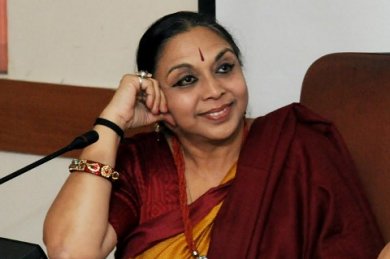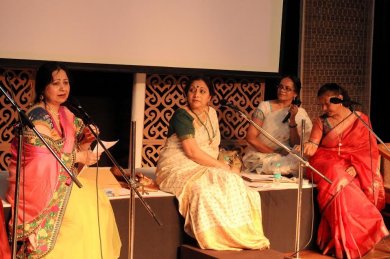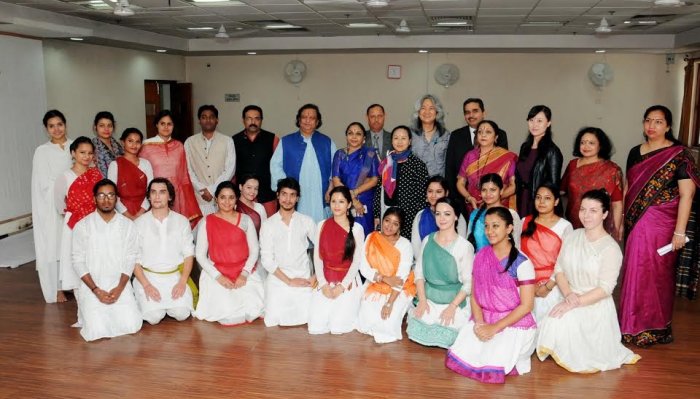
|   |

|   |
 e-mail: ukb7@rediffmail.com Changing faces of Kathak Kendra January 18, 2017 The well-known tenets of Sangeet Natak Akademi, India’s apex body of the performing arts, overview “the vast (tangible and) intangible heritage of our diverse cultural expressions in music, dance and drama”. Over time, SNA has been promoting the practice, growth and awareness of various art forms and led to the setting up of such constituent units as Jawaharlal Nehru Manipuri Dance Akademi, Kathak Kendra, Sattriya Kendra and Rabindra Rangashala; and such centres as Kutiyattam Kendra, Chhau Centre and North-East Centre. Arguably, all the other southern classical forms as Bharatanatyam, Kathakali and Kuchipudi, and the eastern Odissi have so far been left to fend for themselves.  Kamalini Asthana 
Out of the lot, Kathak Kendra started in 1964, some eleven years after the parent SNA began. Since inception, it dedicated itself to mould highly skilled performers of Kathak who would be the next generation of learned “gurus”, choreographers and, above all, intelligent advocates of this art form. Besides making training as the very core of its existence, the Kendra viewed the classical tradition as a constantly evolving body of practices, attitudes, beliefs, skills and aesthetics, and evolved an impressive yearly program of seminars, performances, workshops and lecture-demonstrations, to keep alive dialogue and debate on the growth of Kathak as an art form. Now that over 50 years have elapsed since the Kendra was founded and also that it has moved to a swanky new location -- leaving behind its ramshackle barracks at Mandi House -- one is tempted to look at the sum total of gains and losses over the half century of the Kendra’s eventful existence. How much has been achieved on ground to foster the spirit of growth, diversity and evolution, all of which it vouched for in the beginning? Precisely speaking, has it turned itself into a centre of excellence, or, has it become, over time, a last refuge of the privileged? These questions were put to Kamalini Asthana, the enthusiastic Chairperson of Advisory Committee of the Kendra -- who has been in the saddle now for a year – and herself a well known Kathak exponent. Her answers are indicated below. Was the Kendra lucky to be located in the capital? Indeed, out of all the classical dance-forms, we were fortunate that Kathak got the patronage of SNA in having a national centre in New Delhi and, therefore, it always remained in the limelight in comparison with other forms. It did gain a lot of popularity: whenever there was a chance to present its solo choreographies or group performances and ballets in national and international forums. Have all the gharanas of Kathak been taught at the Kendra? No, the centre always had gurus from only two gharanas: Jaipur and Lucknow. This was a matter of concern for the gurus representing the other gharanas: Varanasi and Raigarh, out of the four dance schools. As you know, nearly 40 students pass out every year. Since 1964 till date, more than 2000 dancers were trained in only two gharanas. The rest of the gharanas were striving hard for their existence. The result was a skewed ratio of 40: 1. How did this affect the national scene? Now, you can well imagine what it was in the national scene: survival of the fittest, rather, majority was authority! Not a single artist or guru of minority gharanas ever dared claim authority in, or for, the presentation of Kathak. Favouritism flourished up to the extent that festivals were sold out to particular gharanas! A national institute became a personal property. I have striven my best to rectify this situation. What other innovations did you introduce? To me, discipline was the first concern. Though it’s a government institution, we must still develop the attitude that we’re entering a place of worship. There should also be other concerns of attitude: students should speak softly, behave reverentially with elders, maintain fraternity feeling with fellow male and female students, show awareness of indigenous values, and maintain a modicum of dress code. How have the students responded to your innovations? You know, students are always sensitive takers and tend to follow the norms. Seniors, of course, should have the responsibility of proving themselves as torch-bearers in all these respects – maybe by helpful attitude, decent conduct, or even day-to-day sacrifices! Furthermore, motivation lectures make them aware of values and they could analyze the difference at a young age as to what helps them to become a true artist. In your most recent tour of the USA, how did you find popularity of Kathak in the West? Our Kathak tour was very informative and successful. We also arranged lectures on Transcendental Meditation (TM) in Maharishi Kendras and in Ekal Vidyalay of the USA.  Interestingly, the present administrative director of the Kendra is Brijbhushan Chugh with no exposure to Kathak dance, but with a 37-year stint in the government, mostly at Sangeet Natak Akademi in a senior capacity. Questions put to him about the Kendra’s recent progress and his answers are given below. Is there student intake from different gharanas? Students are taken from all the four gharanas now, although there is dominance of Lucknow and Jaipur gharanas. Teachers also have a mix of gharanas. What is the teacher-student ratio at present? There are 4 teachers for 175 senior students and 4 teachers for 275 junior students, with 400 students in all. The teacher-student ratio has not undergone much change recently. What have been the current innovations in the Kendra? There have been many changes in the syllabus. Multiple scholarships have been introduced. The Kendra’s repertory company, which had been defunct for quite a while, has been fully revived. Is training given for choreography? Yes, there is now a 2-year training program for choreography for students, over and beyond the traditional format for solo performance. Lastly, what about extension programs? Workshops and seminars are quite regular features now, besides a good number of annual festivals. On the whole, there is great enthusiasm for growth of Kathak.  Dr. Utpal K Banerjee is a scholar-commentator on performing arts over last four decades. He has authored 23 books on Indian art and culture, and 10 on Tagore studies. He served IGNCA as National Project Director, was a Tagore Research Scholar and is recipient of Padma Shri. Post your comments Please provide your name and email id when you use the Anonymous profile in the blog to post a comment. All appropriate comments posted with name & email id in the blog will also be featured in the site. |